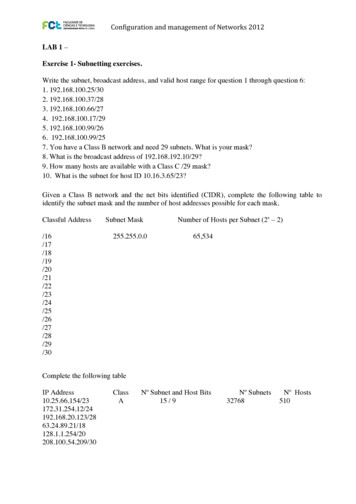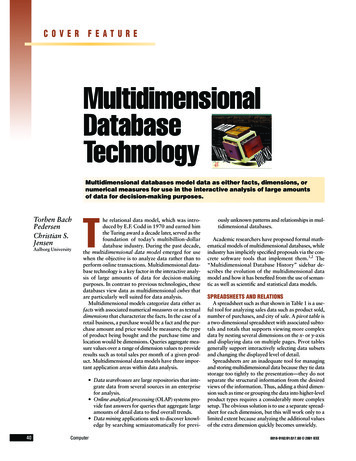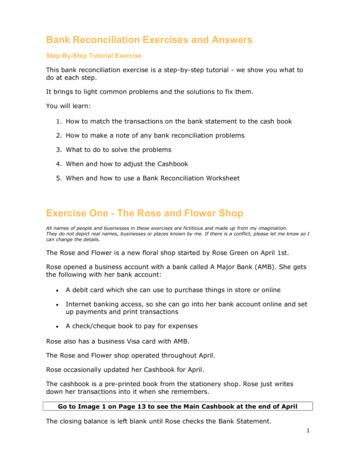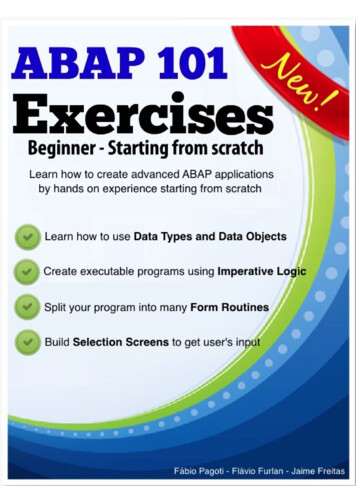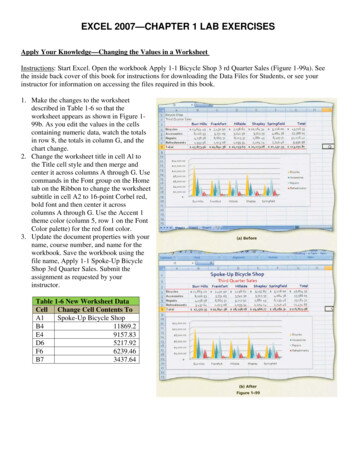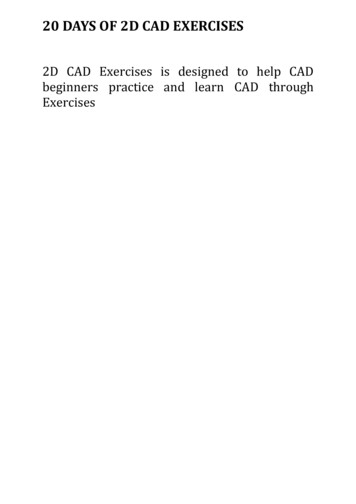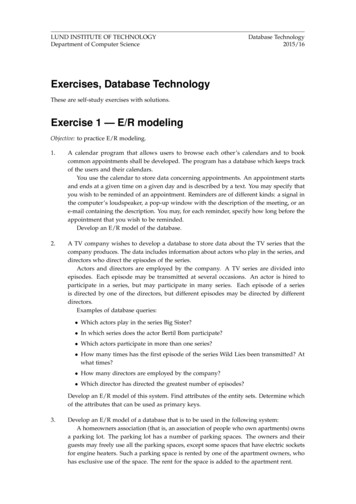
Transcription
LUND INSTITUTE OF TECHNOLOGYDepartment of Computer ScienceDatabase Technology2015/16Exercises, Database TechnologyThese are self-study exercises with solutions.Exercise 1 — E/R modelingObjective: to practice E/R modeling.1.A calendar program that allows users to browse each other’s calendars and to bookcommon appointments shall be developed. The program has a database which keeps trackof the users and their calendars.You use the calendar to store data concerning appointments. An appointment startsand ends at a given time on a given day and is described by a text. You may specify thatyou wish to be reminded of an appointment. Reminders are of different kinds: a signal inthe computer’s loudspeaker, a pop-up window with the description of the meeting, or ane-mail containing the description. You may, for each reminder, specify how long before theappointment that you wish to be reminded.Develop an E/R model of the database.2.A TV company wishes to develop a database to store data about the TV series that thecompany produces. The data includes information about actors who play in the series, anddirectors who direct the episodes of the series.Actors and directors are employed by the company. A TV series are divided intoepisodes. Each episode may be transmitted at several occasions. An actor is hired toparticipate in a series, but may participate in many series. Each episode of a seriesis directed by one of the directors, but different episodes may be directed by differentdirectors.Examples of database queries: Which actors play in the series Big Sister? In which series does the actor Bertil Bom participate? Which actors participate in more than one series? How many times has the first episode of the series Wild Lies been transmitted? Atwhat times? How many directors are employed by the company? Which director has directed the greatest number of episodes?Develop an E/R model of this system. Find attributes of the entity sets. Determine whichof the attributes that can be used as primary keys.3.Develop an E/R model of a database that is to be used in the following system:A homeowners association (that is, an association of people who own apartments) ownsa parking lot. The parking lot has a number of parking spaces. The owners and theirguests may freely use all the parking spaces, except some spaces that have electric socketsfor engine heaters. Such a parking space is rented by one of the apartment owners, whohas exclusive use of the space. The rent for the space is added to the apartment rent.
Exercise 1 — E/R modeling2The spaces with electric outlets are popular, and there is a queue of apartments thatwish to rent such a space. Each apartment may have at most one place in the queue. Whena space becomes available, the apartment with the longest queue time may rent it. Oneof the apartment owners must sign the contract (an apartment may have more than oneowner, and an owner may own more than one apartment).The association sometimes has problems with scrap cars that are deposited in theparking lot. It is often a difficult procedure to get rid of these cars. Discovery of ascrap car must be registered in the database, as well as each thing that happens withthe car (Parking space 43: 2009–04–26 “Discovered suspect car, license number XYZ789”,2009–05–02 “Called the police about the car”, and so on).4.A municipality needs a database containing information concerning the inhabitants of themunicipality. The database will be used for the planning of schools, health care and childcare.From the database, you should be able to receive answers to queries of the followingtypes: How many boys and girls will start school during year x? How many people will become old-age pensioners during year x? How many households have more than x people? How many people are single parents? In how many households is at least one member unemployed? How many households have a total income that is less than the norm for receivingsocial benefits?Develop an E/R model of the database, including attributes and primary keys. Carefullyconsider the representation of “household” and “parent”.
Exercise 2 — from E/R to relations, SQL3Exercise 2 — from E/R to relations, SQLObjective: to practice translating E/R diagrams into relations and assessing advantages anddisadvantages of different translation alternatives. You will also practice more E/R modeling andSQL.1.A company produces and sells products that are assembled from parts. A part is eithermanufactured internally or bought from a supplier. In the company database this ismodeled as follows:ProductproductIdnamePart0.* ameaddressa) Translate the E/R diagram into relations. Make the translation of the hierarchicalstructure between the Part entity sets in three variants, according to the three methodsdescribed in the textbook.b) Describe some typical tasks that the company wishes to solve with the help of thedatabase, and some typical questions to which the company wishes to receive answers.c) Which are the advantages and disadvantages with the different alternatives for therelations for the Part entity sets, when you wish to answer the questions in questionb?2.The E/R diagram below describes a web store, which sells DVD’s and CD’s (“items”) tocustomers. Items may belong to several categories. Customers may write reviews of theitems that they have purchased.Translate the E/R model into a relational model. weak liveryDateA medical health research project has a database containing data about all patients at ahospital. For each patient, data about the symptoms that the patient shows is registered:fever, headache, cough, chest pains, . . . Symptoms can have different severity: low, middle,or high. A patient may show several symptoms, e.g., high fever, medium headache andsome cough.
Exercise 2 — from E/R to relations, SQL4The database also contains data about diseases. Each disease is characterized bydifferent symptoms: a patient with a cold should have fever and a cough, a malaria patientshould have fever and fits of shivering, etc.a) Describe this system in an E/R model.b) Translate the E/R model into a relational model.c) Write SQL statements that answer the following questions (you may define and useviews, if you wish). Find the names of all patients that: don’t have any symptom of high severity, have at least two different symptoms, have at least one of the symptoms of malaria, have all the symptoms of malaria.4.Shops sell items at varying prices. Customers buy items from shops. This is described bythe following relations:Shops(shopId, name, address)Items(itemId, name, description)Sells(shopId, itemId, price)Customers(customerId, name, address)Sales(saleId, customerId, itemId, shopId, date)Draw a diagram in question ?, write SQL statements in questions ?–? (you may createand use views).a) Draw an E/R diagram that describes the database.b) Create the table Sells. Invent suitable types for the attributes (itemId shall have thetype char(10)) and indicate reasonable integrity constraints.c) Print the name and address of all customers who haven’t bought any item.d) Print the number of shops that sell items with id’s starting with ’EF’.e) Print the name and address of the shop(s) that sell the item with id ’EF123-A’ atthe lowest price.f) For all customers that have bought at least one item: print the customer id and thetotal sum of all purchases.
Exercise 3 — FD’s and normalization5Exercise 3 — FD’s and normalizationObjective: to practice finding functional dependencies, finding keys and normalizing relations.1.The relation R(A, B, C, D, E) has the following functional dependencies:FD1.FD2.FD3.FD4.FD5.A CB DAC DCD EE ADetermine all the keys of the relation.2.The relation R(A, B, C, D) has the following functional dependencies:FD1.FD2.FD3.D ACA BB Ca) What are the keys of the relation?b) Show that the relation is not in BCNF and not in 3NF.c) Decompose the relation into smaller relations that are in BCNF.3.A company has several employees, all with different names, who perform interviews withjob applicants (one applicant is interviewed by one employee). The job applicants also havedifferent names. The interviewer makes appointments for interviews with the applicants.Each applicant may be interviewed at several occasions, possibly by different interviewers,but in that case the interviews take place during different days.The company has special interview rooms. Each interviewer uses the same room for allinterviews during a day. A room may, however, be used by different interviewers during aday, as long as the interviews don’t collide in time.The reservation of interview appointments is to be computerized. The database developer has decided to use a single relation for all data, with the following schema:Interviews(interviewer, applicant, day, time, room)a) From the text, find functional dependencies in the relation.b) Find the keys of the relation.c) Show that the relation is in 3NF but not in BCNF.d) Decompose the relation in relations that are in BCNF.e) Extra assignment: draw an E/R diagram that describes the system. Try to incorporateall dependencies from the text in the diagram (not easy).4.We wish to develop a database to keep track of persons, their children and their cars. Forthis purpose, we will use the following relation:PersonData(pNbr, pName, pAddress, cNbr, cName, cAddress, aLic, aMake)pNbr, pName, pAddress is the person number, name and address of a person. cNbr,cName, cAddress is the corresponding information for a child. Each person has exactlyone address. aLic, aMake is the license number and make of a car. A car may be owned bymore than one person.a) What are the functional dependencies in this relation?
6Exercise 3 — FD’s and normalizationb) Find the keys of the relation and show that the relation is not in BCNF.c) Decompose the relation into relations that are in BCNF.d) Show that one of the resulting relations violates the 4NF condition.e) Decompose this relation into relations that are in 4NF.f) Draw an E/R diagram that describes the problem and use this diagram to createrelations. Persons and children are considered to be different entity sets. Are theresulting relations the same as the ones that you created in questions ? and ?
Exercise 4 — database design7Exercise 4 — database designObjective: to practice formulating simple queries in relational algebra. Then, you will summarizeyour database knowledge by designing two databases.1.A company organizes its activities in projects. Products that are used in the projects arebought from suppliers. This is described in a database with the following schema:Projects(projNbr, name, city)Products(prodNbr, name, color)Suppliers(supplNbr, name, city)Deliveries(supplNbr, prodNbr, projNbr, number)Write relational algebra expressions that give the following information:a) All information about all projects.b) All information about all projects in London.c) The supplier numbers of the suppliers that deliver to project number 123.d) The product numbers of products that are delivered by suppliers in London.e) All pairs of product numbers such that at least one supplier delivers both products.2.Another company also organizes its activities in projects. Each project has a name and isrun at a specific location. Unfortunately, there are several projects with the same name —it may even be the case that two projects with the same name are run at the same location.Each project has a telephone, which is shared if there is more than one project at the samelocation. Each project has a boss, who is one of the employees of the company.Each company employee has a person number, address and telephone number. Manyof the employees have several telephone numbers (office telephone, cellular 1, cellular 2,. . . ). The employees work in the projects, most of them in more than one project.1 Eachsuch “project employment” starts at a specific date and ends at another date (the end dateof current project employments is unknown).a) Describe the structure of the company in an E/R model.b) Convert the E/R model to a relational model. Indicate attributes that are primarykeys and foreign keys.c) Prove that the relations are in BCNF.3.1In a botanical survey, an inventory is made of the Swedish flora, i.e., it is investigatedwhere different plants grow. Plants are identified by their Latin names: Anemone nemorosa,Ranunculus ficaria, etc.The survey is made at different sites. A site is described by its name (“The Midsummer Meadow in Stolphult”), its type (“meadow”), and its coordinates in the coordinatesystem Swedish Grid (“153100E, 670300N”). At a site, investigations are performed in1 1 m squares. Each square also has coordinates, which are measured relative to the sitecoordinates. For each plant that occurs in a square, the degree of coverage (in percent) isrecorded.Chemical analyses of different chemical properties are performed in some of the squares.Which analyses that are performed may vary, but common measurements are pH and thecontent of different heavy metals. The results of the measurements are given in differentunits: no unit, ppm, etc.However, there are employees who have worked in the same project during all their time in the company. Furthermore,there are employees who do not participate in a project, e.g., new employees.
Exercise 4 — database design8The survey involves a lot of people. Each person has a person number, name, andaddress. Each square is investigated by one person.a) Develop an E/R model that describes the survey.b) Translate the E/R model into a relational model. All relations must be in BCNF (prove,or at least motivate care
database, and some typical questions to which the company wishes to receive answers. c) Which are the advantages and disadvantages with the different alternatives for the relations for the Part entity sets, when you wish to answer the questions in question b? 2. The E/R diagram below describes a web store, which sells DVD’s and CD’s (“items”) to customers. Items may belong to several .
